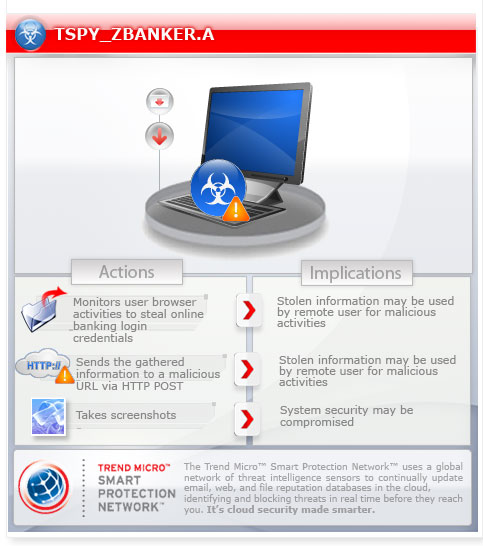TSPY_ZBANKER.A
Windows 2000, Windows XP, Windows Server 2003


Threat Type: Spyware
Destructiveness: No
Encrypted: No
In the wild: Yes
OVERVIEW
This malware is involved in attacks which targeted specific banking corporations in Korea during November 2012.
To get a one-glance comprehensive view of the behavior of this Spyware, refer to the Threat Diagram shown below.

This spyware arrives on a system as a file dropped by other malware or as a file downloaded unknowingly by users when visiting malicious sites.
It acts as a Browser Helper Object (BHO) that monitors a user's Internet-browsing habits.
It logs a user's keystrokes to steal information.
TECHNICAL DETAILS
Arrival Details
This spyware arrives on a system as a file dropped by other malware or as a file downloaded unknowingly by users when visiting malicious sites.
Installation
This spyware drops the following files:
- %Program Files%\IEHelper\IeHelper.dll - also detected as TSPY_ZBANKER.A
- %User Profile%\IEHelper\visited.dat - log of visited target banking sites
(Note: %Program Files% is the default Program Files folder, usually C:\Program Files.. %User Profile% is the current user's profile folder, which is usually C:\Windows\Profiles\{user name} on Windows 98 and ME, C:\WINNT\Profiles\{user name} on Windows NT, and C:\Documents and Settings\{user name} on Windows 2000, XP, and Server 2003.)
It drops the following copies of itself into the affected system:
- %System%\UpDate.exe
(Note: %System% is the Windows system folder, which is usually C:\Windows\System on Windows 98 and ME, C:\WINNT\System32 on Windows NT and 2000, or C:\Windows\System32 on Windows XP and Server 2003.)
Its DLL component is injected to the following process(es):
- explorer.exe
It creates the following folders:
- %Program Files%\IEHelper
- %User Profile%\IEHelper
(Note: %Program Files% is the default Program Files folder, usually C:\Program Files.. %User Profile% is the current user's profile folder, which is usually C:\Windows\Profiles\{user name} on Windows 98 and ME, C:\WINNT\Profiles\{user name} on Windows NT, and C:\Documents and Settings\{user name} on Windows 2000, XP, and Server 2003.)
Autostart Technique
This spyware adds the following registry entries to enable its automatic execution at every system startup:
HKEY_LOCAL_MACHINE\SOFTWARE\Microsoft\
Windows\CurrentVersion\Run
IEHelpRun = "%System%\UpDate.exe"
It registers itself as a BHO to ensure its automatic execution every time Internet Explorer is used by adding the following registry keys:
HKEY_LOCAL_MACHINE\SOFTWARE\Microsoft\
Windows\CurrentVersion\Explorer\
Browser Helper Objects\{BBC9FDC7-26C6-4BED-B907-68BD01C058E2}
It acts as a Browser Helper Object (BHO) that monitors a user's Internet-browsing habits.
Other System Modifications
This spyware adds the following registry keys:
HKEY_CLASSES_ROOT\CLSID\{BBC9FDC7-26C6-4BED-B907-68BD01C058E2}
HKEY_CLASSES_ROOT\Interface\{5D120EBF-7215-4665-BEBF-0FED811643AA}
HKEY_CLASSES_ROOT\TTIEBHO.IEHelper.1
HKEY_CLASSES_ROOT\TTIEBHO.TrackIE
HKEY_CLASSES_ROOT\TypeLib\{C8915F1F-B84E-4AA0-9648-E2CC8E4A194C}
Information Theft
This spyware gathers the following data:
- MAC address
- Internet explorer version
- Operating system version
It logs a user's keystrokes to steal information.
Stolen Information
This spyware sends the gathered information via HTTP POST to the following URL:
- http://{BLOCKED}o.{BLOCKED}0.my5m.com/tongji/123321/count.asp?mac={MAC address}&iever={IE version}&os={OS version}
NOTES: It monitors if the user access one of the following URLs from banking sites:
If the user access one of these URLs they are redirected to the following phishing pages that mimic the official banking sites, to get a user’s bank information, such as user names, passwords, or card codes:
It saves which banking sites have already been visited in ;%User Profile%\IEHelper\visited.dat.
It is also capable of capturing screen shots.
This spyware initially connects to the following URL in order to get target banking sites:
SOLUTION
Step 1
For Windows XP and Windows Server 2003 users, before doing any scans, please make sure you disable System Restore to allow full scanning of your computer.
Step 2
Restart in Safe Mode
Step 3
Delete this registry key
Important: Editing the Windows Registry incorrectly can lead to irreversible system malfunction. Please do this step only if you know how or you can ask assistance from your system administrator. Else, check this Microsoft article first before modifying your computer's registry.
- In HKEY_LOCAL_MACHINE\SOFTWARE\Microsoft\Windows\CurrentVersion\Explorer\Browser Helper Objects
- {BBC9FDC7-26C6-4BED-B907-68BD01C058E2}
- {BBC9FDC7-26C6-4BED-B907-68BD01C058E2}
- In HKEY_CLASSES_ROOT\CLSID
- {BBC9FDC7-26C6-4BED-B907-68BD01C058E2}
- {BBC9FDC7-26C6-4BED-B907-68BD01C058E2}
- In HKEY_CLASSES_ROOT\Interface
- {5D120EBF-7215-4665-BEBF-0FED811643AA}
- {5D120EBF-7215-4665-BEBF-0FED811643AA}
- In HKEY_CLASSES_ROOT
- TTIEBHO.IEHelper.1
- TTIEBHO.IEHelper.1
- In HKEY_CLASSES_ROOT
- TTIEBHO.TrackIE
- TTIEBHO.TrackIE
- In HKEY_CLASSES_ROOT\TypeLib
- {C8915F1F-B84E-4AA0-9648-E2CC8E4A194C}
- {C8915F1F-B84E-4AA0-9648-E2CC8E4A194C}
Step 4
Delete this registry value
Important: Editing the Windows Registry incorrectly can lead to irreversible system malfunction. Please do this step only if you know how or you can ask assistance from your system administrator. Else, check this Microsoft article first before modifying your computer's registry.
- In HKEY_LOCAL_MACHINE\SOFTWARE\Microsoft\Windows\CurrentVersion\Run
- IEHelpRun = "C:\WINDOWS\system32\UpDate.exe"
- IEHelpRun = "C:\WINDOWS\system32\UpDate.exe"
Step 5
Search and delete these folders
- %Program Files%\IEHelper
- %User Profile%\IEHelper
Step 6
Restart in normal mode and scan your computer with your Trend Micro product for files detected as TSPY_ZBANKER.A. If the detected files have already been cleaned, deleted, or quarantined by your Trend Micro product, no further step is required. You may opt to simply delete the quarantined files. Please check this Knowledge Base page for more information.
Did this description help? Tell us how we did.

